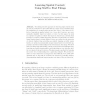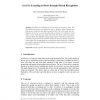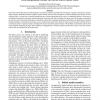229 search results - page 7 / 46 » Learning spatial relations in object recognition |
ECCV
2008
Springer
14 years 9 months ago
2008
Springer
The sliding window approach of detecting rigid objects (such as cars) is predicated on the belief that the object can be identified from the appearance in a small region around the...
CVPR
2007
IEEE
14 years 9 months ago
2007
IEEE
This paper presents a method of learning and recognizing generic object categories using part-based spatial models. The models are multiscale, with a scene component that specifie...
CVPR
2005
IEEE
14 years 9 months ago
2005
IEEE
We present a class of statistical models for part-based object recognition that are explicitly parameterized according to the degree of spatial structure they can represent. These...
SG
2010
Springer
14 years 18 days ago
2010
Springer
iCanDraw is a drawing tool that can assist novice users to draw. The goal behind the system is to enable the users to perceive objects beyond what they know and improve their spati...
LREC
2010
13 years 9 months ago
2010
One of the essential functions of natural language is to talk about spatial relationships between objects. Linguistic constructs can express highly complex, relational structures ...



